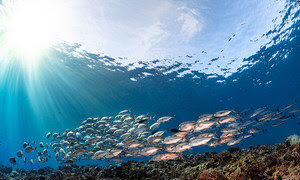by Sahana Ghosh on 13 December 2019
• Scientists are exploring the use of satellites to track ocean acidification in the Greater Caribbean, the Amazon Plume and the Bay of Bengal.
• Under a European Space Agency funded project, researchers at IISER-Kolkata are merging satellite data and on-ground observations to monitor the health of coastal Bay of Bengal in the Sundarbans delta.
• At the annual global climate talks in Madrid, Spain, experts have sounded the alarm over the world’s oceans coming under assault.With the annual global climate talks in Madrid sounding the alarm over the world’s oceans coming under assault, a new study describes how scientists are exploring the use of satellites to track ocean acidification in the Greater Caribbean, the Amazon Plume and the Bay of Bengal.
Experts warn that many fragile coastal ecosystems such as coral reefs, mangroves and lagoons will become vulnerable and reel from the effects of ocean acidification due to change in coastal water carbonate chemistry, leading to loss of biodiversity and impacting fisheries.
Until recently, it has been difficult to monitor ocean acidification, but scientists are exploring new ways to combine information from different sources, including from European Space Agency’s (ESA) SMOS mission and NASA’s Aquarius, to shed new light on this major environmental concern, said an ESA statement on the study by an international team of researchers from the United Kingdom, France, China, Italy, United States and the Indian Institute of Science Education and Research in India.
Since the beginning of the industrial revolution (which took place from the 18th to 19th centuries), humans have released approximately 500 billion metric tons of carbon into the atmosphere from burning fossil fuels, cement production and land-use changes. About 30 percent of this carbon dioxide has been taken up (or absorbed) by the oceans. As the ocean absorbs carbon dioxide, it leads to a change in marine carbonate chemistry, resulting in a decrease of seawater pH (decrease in alkalinity and increase in acidity) and carbonate ion concentration, a situation which is commonly called ‘ocean acidification’.

Under the European Space Agency funded project ESA Pathfinders Ocean Acidification, in 2015 researchers at IISER-Kolkata began exploring how ground observations on salinity and temperature from the coastal Bay of Bengal in the Sundarbans delta could be plugged in with earth observation satellite data to fill in the gaps and paint a complete picture.
Leading the Bay of Bengal charge, IISER-Kolkata’s Punyasloke Bhadury, says the current paper is a validation of the ability of satellites to track ocean acidification.
“This is particularly important for coastal Bay of Bengal which is considered to be vulnerable and faces threats from ocean acidification with immense consequences for socio-economics of the region,” Bhadury told Mongabay-India, adding that the catchment areas along the Bay are home to 400 million people.
Researchers said marine chemistry can be studied using four parameters: partial pressure of carbon dioxide in the water, dissolved inorganic carbon, alkalinity and pH. Any two of these parameters, along with measurements of salinity and temperature, allow us to understand the complete carbon chemistry of the ocean.
“Salinity and temperature strongly control ocean carbonate chemistry which is linked to acidification. We also had alkalinity data from in-situ measurements in the coastal Bay of Bengal. The earth observation satellites picked up theoretical data on salinity and temperature on the region and that was cross-verified with our in-situ data,” said Bhadury.
While at present there aren’t any spaceborne sensors that can measure pH directly, taking measurements from space provides a global view. At the outset of the project in 2015, Bhadury and collaborators published a paper positing that “you don’t need to go into these challenging terrains to measure changes in ocean health once you have the in-situ data and have established the correct baseline from satellite datasets.”
The study describes how scientists are testing new ways of merging different datasets to estimate and ultimately monitor ocean acidification.
ESA’s SMOS mission (or Soil Moisture-Ocean Salinity) and NASA’s Aquarius mission, both of which provide information on ocean salinity, have been key to the research. The work was supported through access to thousands of collated and quality controlled measurements collected by the international community from ships and research campaigns.
Also crucial to the understanding of sea surface temperature is ESA’s Sea Surface Temperature Climate Change Initiative (SST CCI) dataset that accurately maps the surface temperature of the global oceans over the period 1991 to 2010, using observations from many satellites.
The ground observations in the Bay of Bengal specifically were with the support of the Sundarbans Biological Observatory Time Series (SBOTS), set up by Bhadury and colleagues on sites along the coastal Bay of Bengal in India’s West Bengal state. The time series maps data monthly to pinpoint trends in the health of the Sundarbans ecosystem.
Complexities in the Bay of Bengal throw off satellite measurements
“We need to know the right approach in how to use satellites to track ocean health. There are many satellites that can do the job. The coastal Bay of Bengal is a very challenging region because of the cloud cover and the satellite can’t map the ocean surface very clearly so the satellite can make a lot of errors and it is important to make corrections into the satellite algorithms by incorporating in-situ measurements,” Bhadury said.
In situ measurements of carbonate parameters in Sundarbans Biological Observatory Time Series (SBOTS) site along the coastal Bay of Bengal, when validated, highlighted low satellite sea surface salinity coverage due to radio frequency interference as well as the complexities associated with the freshwater flow, source and sink of carbon dioxide, among others.
Therefore, optimisation of satellite data with in situ measurements is paramount to improve the ability of satellites to track ocean acidification in the coastal Bay of Bengal, Bhadury added.
“Because of the time-series set up in 2010, we have data on different parameters (salinity, temperature and alkalinity) throughout the year for each of the years the time-series observatory has been operational. Our data is used as a base to figure out if the satellite has made mistakes or not,” he said.
Impacts of ocean acidification, including on livelihoods, already visible
Researchers underline that with the damaging effects of ocean acidification already becoming evident, it is vital that the current shift in pH is monitored closely. “The changes in ocean chemistry will be minuscule but the impact is huge and we really need to be precise,” said Bhadury.
Last week, at the United Nations’ Climate Change Conference (COP25) in Madrid, Spain, the World Meteorological Organisation announced that concentrations of greenhouse gases in the atmosphere have reached yet another high. The ocean, which acts as a buffer by absorbing heat and carbon dioxide, is paying a heavy price.
In the decade 2009-2018, the ocean absorbed around 22 percent of the annual emissions of carbon dioxide, which helps to attenuate climate change. However, increasing atmospheric carbon dioxide concentrations affect the chemistry of the ocean.
Ocean observations have shown a decrease in the average global surface ocean pH at a rate of 0.017–0.027 pH units per decade since the late 1980s, as reported in the IPCC Special Report on the Ocean and Cryosphere in a Changing Climate, which is equivalent to an increase in acidity of 26 percent since the beginning of the industrial revolution.
This long-term absorption results in a shift in ocean carbonate chemistry, which has the potential to alter biogeochemical cycles and ecosystem function in the future. As a result of the decrease in ocean pH arising from these shifts (often termed ocean acidification), this change in ocean carbonate chemistry has received increasing scientific and political attention over the past decade, the authors write in the study.
More than 400 million people reside along the catchment area of Bay of Bengal. The livelihood of many of these people is dependent on marine resources of Bay of Bengal including fisheries. More than 2 million fishermen are directly involved in coastal fisheries and a majority of them are from India, explained Bhadury. The value of catch has been estimated to be more than a billion U.S. dollars per year in India alone since 2000. Similarly, tourism income contributes to 15 percent of national Gross Domestic Product (GDPs) of coastal nations surrounding the Bay of Bengal.
“Sundarbans, one of the most biologically rich ecosystems also serves as the spawning ground of rich coastal fisheries of Bay of Bengal. Ocean acidification can severely alter the availability of food resources (e.g. plankton) required for coastal fish populations to thrive. This can ultimately lead to a crash of coastal fisheries and livelihood in the region,” he said.
Moreover, many fragile coastal ecosystems such as coral reefs, mangroves and lagoons will become vulnerable and reel from the effects of ocean acidification due to change in coastal water carbonate chemistry and thus leading to loss of biodiversity. It could also lead to catastrophic consequences for ocean health and also for tourism of Bay of Bengal nations including India, warned Bhadury.
CITATION
Land, P. E., Findlay, H. S., Shutler, J. D., Ashton, I. G., Holding, T., Grouazel, A.… & Quilfen, Y. (2019). Optimum satellite remote sensing of the marine carbonate system using empirical algorithms in the global ocean, the Greater Caribbean, the Amazon Plume and the Bay of Bengal. Remote Sensing of Environment, 235, 111469.
– Mongabay India




